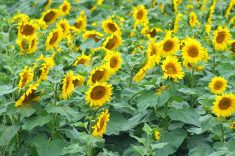MarketsFarm PRO analyst Mike Jubinville said Statistics Canada’s principal field crop production report, released Thursday, did not contain too many surprises.
The agency’s previous report on Aug. 29 already provided insight as to what production numbers were going to be, he said, but still warned the model-based projections in the latest report will not be as accurate as the survey-based report due out in December.
“Given how advanced the crop was on the (previous) report on Aug. 29, we probably had a pretty good idea as to where the problem areas were, in terms of the brownness that you’d see from the satellite (imagery),” Jubinville said.
Read Also

U.S. livestock: CME cattle futures end lower, hogs mostly lower
Chicago | Reuters – Chicago Mercantile Exchange (CME) cattle futures turned lower on Friday on profit taking, inflation concerns and…
“In the good areas where it was greener, it was a little difficult to say exactly how well those areas are performing. I think, from a trade point of view, they believe the numbers are probably saying that production is a bit understated.”
Despite questions over the report’s accuracy, adjustments to the production figures compared to the August report were modest and mostly expected. One of the few surprises was the canola production estimate being revised downward by nearly 200,000 tonnes, to 17.368 million, after the trade had expected a 300,000-tonne raise.
However, Jubinville doesn’t think any of the adjustments, including that for canola, had effects on the markets.
“Canola operates in an environment of many oilseeds and vegetable oils from a global perspective. What happens in Canada doesn’t necessarily change the price unless we have a dramatic issue above expectations or below expectations,” he said. “But I don’t think (today) was enough here to really change the market outlook for now.”
The report highlighted how much the hot and dry weather in the Prairies cut production for Canada’s major crops. Other than small increases for chickpeas, corn, mustard seed and winter wheat, all other crops saw decreases compared to 2022-23.
“Canada doesn’t have an abundant supply this year,” Jubinville remarked.
Yield estimates for cereals were the hardest hit by the summer weather, with yield declines in wheat (down 17.6 per cent), including durum (29 per cent) and spring wheat (18 per cent). Barley yields are estimated down 22.2 per cent from 2022-23, while oats, which already saw a major drop in seeded area, saw its yield fall by 21.2 per cent, causing a 53.4 per cent drop in production.
“I think (the declines roughly fall) within the range of expectations,” Jubinville said. “Barley is tight, but the price of barley is too high for export. That’s OK. We’ll feed it domestically.
“As such, we are going to be tied to the hip to what the U.S. corn market is doing. And if U.S. corn is under pressure, barley is going to feel that pressure, competitive pressure,” he said.
“Oats have coverage in the immediate weeks and months going forward (because of last year’s crop). But with this small crop, we have a tightness scenario that is going to be felt in the second half of the (marketing) year and the market’s going to have to respond.”
— Adam Peleshaty reports for MarketsFarm from Stonewall, Man.
















